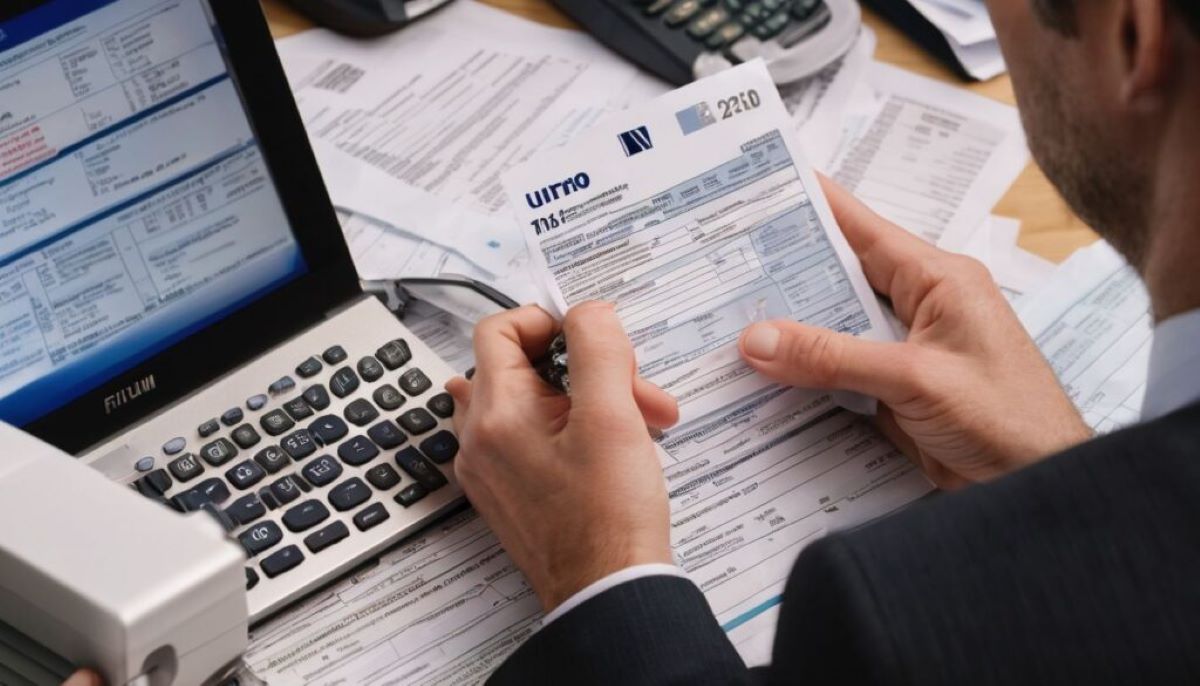

Finance
What Is A Trade Credit Reference
Modified: February 21, 2024
Learn about trade credit references and how they impact finances. Understand the importance of credit references in financial transactions.
(Many of the links in this article redirect to a specific reviewed product. Your purchase of these products through affiliate links helps to generate commission for LiveWell, at no extra cost. Learn more)
Table of Contents
- Introduction
- Definition of Trade Credit Reference
- Importance of Trade Credit References
- How Trade Credit References Are Obtained
- What Information Is Included in a Trade Credit Reference
- Factors Considered in a Trade Credit Reference
- Benefits of Having Good Trade Credit References
- Disadvantages of Poor Trade Credit References
- How to Improve Your Trade Credit References
- Conclusion
Introduction
Welcome to the world of trade credit references! In the dynamic realm of finance, where businesses rely heavily on credit transactions, trade credit references play a vital role. Whether you’re a small business owner or a seasoned entrepreneur, understanding the importance and intricacies of trade credit references can significantly impact the success of your business.
A trade credit reference is a report that provides information about a company’s creditworthiness and payment history. It acts as a verification tool for potential creditors and suppliers who want to assess the financial health and reliability of a business before entering into a credit agreement. Essentially, it serves as a snapshot of a company’s financial standing, allowing others to make informed decisions regarding credit extensions.
Trade credit references are obtained from various sources, including banks, financial institutions, and trade credit bureaus. These references contain essential details such as payment history, credit limits, outstanding balances, and the overall creditworthiness of a company. Lenders and suppliers rely heavily on this information to determine the level of risk associated with extending credit to a particular business.
Throughout this article, we will explore the importance of trade credit references, how they are obtained, the information included in such references, and the factors considered by creditors. We will also discuss the benefits of having good trade credit references, as well as the drawbacks of poor references. Finally, we will provide tips on how to improve your trade credit references, enabling you to strengthen your company’s financial standing and increase your chances of securing favorable credit terms.
So, whether you’re a business owner looking to establish solid creditworthiness or a creditor seeking reliable partners, join us on this journey through the world of trade credit references. Let’s explore how this crucial aspect of finance can greatly impact the success and growth of your business.
Definition of Trade Credit Reference
Before delving into the intricacies of trade credit references, it’s essential to establish a clear understanding of what they are. A trade credit reference is a report or document that provides comprehensive information regarding a company’s creditworthiness and payment history. It is essentially a tool used by creditors and suppliers to assess the financial reliability of a business before entering into a credit agreement.
At its core, a trade credit reference serves as a form of verification, giving potential creditors insight into a company’s financial standing. It provides a snapshot of the company’s creditworthiness, detailing its ability to meet financial obligations and its track record in making timely payments.
Trade credit references are obtained from various sources, including banks, financial institutions, credit agencies, and trade credit bureaus. These sources collect and analyze financial data from businesses and compile it into a comprehensive report. The report typically includes details such as the company’s payment history, credit limits, outstanding balances, and any delinquencies or defaults.
When a business applies for credit, the creditor or supplier will often request a trade credit reference to assess the company’s creditworthiness. This reference serves as a crucial factor in the decision-making process, as it helps determine the level of risk associated with extending credit to that particular business. A positive trade credit reference indicates that the company is reliable and capable of fulfilling its financial obligations, making it more likely to secure favorable credit terms.
On the other hand, a negative trade credit reference can raise concerns about a company’s financial stability and payment history. This, in turn, can lead to higher interest rates, stricter credit terms, or even rejection of credit applications altogether. Therefore, it is crucial for businesses to maintain positive trade credit references to establish a strong credit profile and enhance their financial reputation in the market.
Now that we have established the definition of trade credit references, let’s explore their significance and why they are vital for businesses in the next section.
Importance of Trade Credit References
Trade credit references are of utmost importance in the world of finance and business. They serve as a crucial tool for both creditors and businesses looking to establish creditworthiness, build trust, and ensure financial stability. Let’s explore why trade credit references are so significant:
Assessing Creditworthiness: Trade credit references allow creditors and suppliers to evaluate the creditworthiness of a business. By examining a company’s payment history, credit limits, and outstanding balances, creditors can assess the level of risk associated with extending credit. This information helps them make informed decisions on whether to grant credit, the credit terms, and the amount of credit to offer.
Minimizing Risk: Trade credit references help minimize the risk of non-payment or default. Creditors and suppliers can use these references to gauge a company’s financial stability and how well it manages its finances. By extending credit to businesses with positive trade credit references, creditors can have greater confidence that payments will be made on time and in full.
Building Trust: Maintaining good trade credit references is not only beneficial for obtaining credit but also for building strong relationships with creditors and suppliers. Positive trade credit references demonstrate a company’s reliability and accountability in meeting financial obligations, increasing trust and enhancing the likelihood of future credit approvals, favorable credit terms, and even potential partnerships.
Access to Favorable Credit Terms: A positive trade credit reference can lead to more favorable credit terms, such as lower interest rates, higher credit limits, and extended payment terms. This can significantly benefit a business by improving cash flow, allowing for more flexibility in managing finances, and enabling investments in growth opportunities.
Competitive Advantage: Maintaining good trade credit references can give a business a competitive edge in the market. It can help attract potential creditors and suppliers who may be more inclined to form partnerships or offer preferential terms based on a business’s financial track record. Positive references can also be advantageous when bidding for contracts or securing financing for expansion projects.
Business Growth and Expansion: Trade credit references play a vital role in the growth and expansion of a business. By maintaining positive references, businesses can access the necessary credit to fund new ventures, invest in infrastructure, purchase inventory, or expand their operations. This, in turn, allows for increased market reach, improved competitiveness, and potential for higher profits.
Overall, trade credit references are essential for businesses looking to establish and maintain good creditworthiness. They not only help mitigate risks but also open doors to opportunities for growth and success. In the next section, we will explore how trade credit references are obtained and what information is typically included in them.
How Trade Credit References Are Obtained
Obtaining trade credit references is a crucial step in establishing a business’s creditworthiness and financial reputation. These references are acquired from various sources that collect and compile information on a company’s credit history and payment performance. Let’s explore how trade credit references are obtained:
Suppliers and Creditors: One of the primary sources of trade credit references is the suppliers and creditors a business works with. When businesses apply for credit terms or credit extensions, suppliers and creditors may request permission to contact other companies that have previously done business with the applicant. These references provide valuable insights into the applicant’s payment behavior, reliability, and financial stability.
Trade Credit Bureaus: Trade credit bureaus act as centralized repositories of credit information. They collect and maintain data from various sources, including businesses, lenders, and suppliers. Many credit bureaus offer comprehensive credit reporting services, providing trade credit references to businesses upon request. These reports typically include detailed information about a company’s payment history, credit limits, outstanding balances, and any financial delinquencies or defaults.
Financial Institutions: Banks and other financial institutions can also provide trade credit references. Since they often have financial relationships with businesses, they can offer insights into a company’s financial health and creditworthiness. Lenders may provide references based on a business’s banking activities, loans, or lines of credit. These references can carry significant weight, as they come directly from trusted financial entities.
Industry Associations: Some industry associations collect and share trade credit references among their members. These associations act as networking platforms for businesses within specific industries and often have mechanisms in place to verify and exchange credit information. Participating in such associations can provide access to reliable trade credit references and a network of trusted business contacts.
Credit Reports: Another method of obtaining trade credit references is through credit reports provided by credit reporting agencies. These reports compile data from various sources, including public records, financial institutions, and trade credit bureaus. Credit reports provide a comprehensive overview of a business’s credit history, including detailed information about its payment performance, credit utilization, and any negative financial events.
Trade References: In addition to the above sources, businesses can also provide their own trade references when applying for credit. These references typically come from other businesses with which they have ongoing or past trade relationships. Providing positive references from reputable companies can enhance a business’s creditworthiness and increase the chances of receiving favorable credit terms.
It’s important to note that businesses should always seek permission before sharing trade credit references and safeguard the confidentiality and privacy of the information provided. By utilizing these sources, businesses can gather a comprehensive and well-rounded set of trade credit references that reflect their financial standing and creditworthiness.
Now that we understand how trade credit references are obtained, let’s delve into the information typically included in these references in the next section.
What Information Is Included in a Trade Credit Reference
A trade credit reference provides a comprehensive overview of a business’s creditworthiness and payment history. It contains valuable information that helps potential creditors and suppliers assess the financial stability and reliability of a company. Let’s explore the key information typically included in a trade credit reference:
Company Information: The trade credit reference begins with basic company information, such as the legal name, business address, contact details, and identification numbers, such as the Employer Identification Number (EIN) or the company registration number.
Payment History: One of the most critical aspects of a trade credit reference is the payment history. It provides a record of the company’s payment behavior, including the number and frequency of payments made on time, late payments, and any defaults or delinquencies. This information is crucial in assessing a company’s reliability in meeting its financial obligations.
Credit Terms and Limits: The trade credit reference may include details about the credit terms extended to the company, such as the payment period allowed, discount terms, and any specific conditions related to the credit agreement. It may also specify the credit limits assigned to the company, indicating the maximum amount of credit it is authorized to use.
Credit Utilization: The reference may include information about the company’s credit utilization, which refers to the percentage of the available credit that the company has used. This helps creditors and suppliers assess how responsibly a company manages its credit and whether it stays within the prescribed limits or tends to max out its credit lines.
Outstanding Balances: The trade credit reference typically includes details about the company’s outstanding balances, indicating the remaining amounts to be paid to various creditors or suppliers. This information gives an insight into the company’s current financial obligations and helps evaluate its ability to manage its existing debt load.
Public Records and Legal Filings: In some cases, trade credit references may include information from public records and legal filings. This could include records of bankruptcies, liens, judgments, or any legal actions taken against the company, which may have an impact on its creditworthiness.
Trade References: The trade credit reference may also include references from other businesses with whom the company has had trade relationships. These references can provide insights into the company’s reputation, reliability, and payment behavior from a firsthand perspective.
Industry Norms and Comparisons: Some trade credit references may provide industry-specific data and benchmarks to compare a company’s credit performance with industry peers. This allows potential creditors and suppliers to evaluate a company’s standing within its industry and determine if its credit performance is above or below average.
Additional Remarks or Notes: The trade credit reference may include any additional remarks or notes provided by the creditor or supplier. These comments can further explain specific circumstances or provide additional context regarding the company’s creditworthiness and payment history.
It’s important to note that the specific information included in a trade credit reference may vary depending on the source and the level of detail provided by the reporting entity. However, generally, trade credit references encompass a comprehensive set of information that helps evaluate a company’s creditworthiness and financial reliability.
Now that we know the information included in a trade credit reference, let’s explore the factors considered when evaluating these references in the next section.
Factors Considered in a Trade Credit Reference
When evaluating a trade credit reference, creditors and suppliers consider multiple factors to assess the creditworthiness and reliability of a business. These factors help them determine the level of risk associated with extending credit and influence the terms and conditions offered. Let’s explore the key factors typically considered in a trade credit reference:
Payment History: The payment history is a crucial factor in evaluating a trade credit reference. Creditors and suppliers examine whether payments were made on time or if there were late payments, defaults, or delinquencies. A consistently positive payment history demonstrates a company’s reliability in meeting financial obligations and increases its creditworthiness.
Credit Utilization: Creditors and suppliers consider the company’s credit utilization, which refers to the proportion of credit being utilized compared to the total available credit. Lower credit utilization rates are generally viewed more favorably, as they indicate responsible credit management and a reduced risk of overextending the company’s financial resources.
Outstanding Balances: The amount of outstanding balances owed by the company is another factor taken into consideration. Creditors and suppliers analyze the company’s ability to handle its existing debt load and assess whether the outstanding balances may significantly impact its ability to make future payments.
Payment Trends: The trend of payment behavior over time is assessed to identify any patterns of improvement or deterioration in financial performance. Consistent and improving payment trends are viewed positively, while a decline in payment performance may raise concerns about financial stability.
Industry Comparisons: Creditors and suppliers often compare a company’s trade credit reference with industry benchmarks and norms to assess its standing within the industry. A company that performs well relative to its industry peers may be considered more creditworthy, while one that lags behind may be viewed with higher caution.
Length of Credit History: The length of the company’s credit history is taken into account. A longer credit history provides more data points for evaluation and demonstrates the company’s ability to establish and maintain credit relationships over time.
Public Records and Legal Filings: Creditors and suppliers review public records and legal filings for any bankruptcies, liens, judgments, or legal actions taken against the company. Negative records may raise concerns and impact the company’s creditworthiness.
Trade References: The references provided by other businesses with whom the company has had trade relationships are considered. Positive trade references from reputable companies can enhance the company’s credibility and strengthen its trade credit reference.
Financial Stability: Creditors and suppliers assess the overall financial stability of the company, considering factors such as profitability, revenue growth, liquidity, and debt-to-equity ratio. A financially stable company is typically seen as more capable of meeting its financial obligations.
Business Reputation: The company’s reputation within the industry is also taken into account. Factors such as customer reviews, testimonials, and industry recognition play a role in evaluating the company’s reliability and credibility.
It’s important to note that while these factors are commonly considered, the weight assigned to each factor may vary depending on the specific creditor or supplier’s evaluation criteria. Additionally, different industries may have unique factors that are particularly relevant to their credit evaluation process. Therefore, businesses should strive to maintain a positive overall trade credit reference by managing these factors effectively and proactively.
Now that we have explored the factors considered in a trade credit reference, let’s move on to discuss the benefits of having good trade credit references.
Benefits of Having Good Trade Credit References
Having good trade credit references can bring numerous advantages to a business. These references serve as a testament to a company’s creditworthiness and financial reliability, opening doors to various opportunities in the business world. Let’s explore the key benefits of having good trade credit references:
Access to Credit: Perhaps the most significant benefit of having good trade credit references is increased access to credit. Lenders and suppliers are more likely to extend credit to businesses with a positive credit history and reliable payment track record. This allows businesses to obtain the necessary funds to invest in growth, purchase inventory, and manage cash flow efficiently.
Favorable Credit Terms: Good trade credit references can lead to more favorable credit terms. Lenders and suppliers may offer lower interest rates, longer payment periods, higher credit limits, and more flexible repayment options to companies with positive credit references. These favorable terms can significantly enhance a business’s financial position and allow for greater flexibility in managing finances.
Enhanced Reputation and Trust: Positive trade credit references help build a strong reputation and establish trustworthiness within the business community. Potential creditors, suppliers, and partners view businesses with good credit references as reliable and responsible. This can lead to increased trust, stronger business relationships, and potential collaborations, fostering future growth and success.
Competitive Advantage: Having good trade credit references can give a business a competitive edge over its peers. It demonstrates financial stability and reliability, setting the company apart from its competitors. This can be particularly advantageous when bidding for contracts, securing partnerships, or attracting new customers who prioritize companies with a proven track record of financial responsibility.
Improved Cash Flow: Good trade credit references can help improve cash flow management for a business. By having access to credit and favorable credit terms, companies can better manage their working capital, invest in growth opportunities, and maintain a healthy cash flow. This financial flexibility allows for smoother operations and increased financial stability.
Opportunities for Growth: Positive trade credit references provide opportunities for business growth and expansion. With credit readily available, businesses can invest in new products or services, expand into new markets, acquire assets, or hire additional staff. This potential for growth can lead to increased revenues, market presence, and overall profitability.
Building a Strong Credit Profile: Maintaining good trade credit references is essential for building a strong credit profile. Consistently positive credit references contribute to a solid credit history, which can significantly impact future credit applications. A strong credit profile opens doors to new opportunities and secures better credit options, giving the business a solid foundation for future financial endeavors.
Overall, having good trade credit references is invaluable for businesses. It not only facilitates access to credit but also enhances the reputation, competitiveness, and growth potential of a company. Maintaining positive trade credit references should be a priority for businesses aiming to strengthen their financial position and establish long-term success.
Now that we understand the benefits of good trade credit references, let’s explore the potential drawbacks of poor trade credit references in the next section.
Disadvantages of Poor Trade Credit References
Poor trade credit references can have significant disadvantages for a business. They indicate a lack of financial reliability and may hinder a company’s ability to access credit, secure favorable terms, and establish trust within the business community. Let’s explore the key disadvantages of poor trade credit references:
Limited Access to Credit: Perhaps the most significant disadvantage of poor trade credit references is limited access to credit. Lenders and suppliers are hesitant to extend credit to businesses with a history of late payments, defaults, or other negative credit events. This can severely restrict a company’s ability to obtain the necessary financing to operate, grow, and seize opportunities.
Stricter Credit Terms: Poor trade credit references often lead to stricter credit terms. If a business is considered high-risk due to its credit history, creditors and suppliers may impose higher interest rates, shorter payment periods, lower credit limits, and stricter repayment terms. These unfavorable terms can strain cash flow, limit flexibility, and increase the cost of borrowing.
Damaged Reputation and Trust: Poor trade credit references can damage a company’s reputation and erode trust within the business community. When potential creditors, suppliers, or partners see negative credit references, they may question the company’s financial reliability and its ability to meet its obligations. This can lead to strained relationships, difficulty in securing partnerships, and a tarnished reputation that can be challenging to repair.
Competitive Disadvantage: Companies with poor trade credit references face a competitive disadvantage in the market. Other businesses with stronger credit profiles may enjoy preferential treatment from suppliers or access to better credit terms. This can put the company with poor references at a disadvantage when competing for contracts, attracting customers, or securing favorable business relationships.
Cash Flow Challenges: Poor credit references can lead to cash flow challenges. Limited access to credit and stricter credit terms can hinder a business’s ability to manage its working capital effectively. This can result in cash flow gaps, delayed payments to suppliers, difficulty in purchasing inventory, and an overall strain on financial operations.
Stunted Growth Potential: Poor trade credit references can restrict a company’s growth potential. Without access to credit and favorable credit terms, businesses may struggle to invest in expansion projects, hire talented employees, or seize market opportunities. This can limit the company’s ability to scale and compete effectively in the marketplace.
Negative Impact on Future Credit Applications: Poor trade credit references can have a lasting impact on future credit applications. A history of negative credit events can make it challenging to obtain credit from lenders and suppliers. Even if credit is granted, it may come with unfavorable terms and conditions, limiting the company’s financial flexibility and growth opportunities.
It’s essential for businesses to recognize and address poor trade credit references promptly. Taking steps to improve creditworthiness, such as making timely payments, negotiating with creditors, and establishing positive credit relationships, can help mitigate the disadvantages and pave the way for a more favorable credit profile.
Now that we understand the disadvantages of poor trade credit references, let’s explore how businesses can improve their trade credit references in the next section.
How to Improve Your Trade Credit References
Improving trade credit references is crucial for businesses looking to strengthen their creditworthiness and financial reputation. Positive credit references can lead to increased access to credit, favorable terms, and enhanced trust within the business community. Let’s explore some key strategies to improve your trade credit references:
Make Timely Payments: Paying your bills on time is essential for maintaining a positive trade credit reference. Set up systems and reminders to ensure that payments are made promptly and in full. Consistently meeting payment deadlines demonstrates financial responsibility and reliability.
Negotiate Payment Terms: If you’re facing cash flow challenges, consider negotiating more favorable payment terms with your suppliers. Discuss options such as extended payment periods, installment plans, or early payment discounts. By demonstrating open communication and a commitment to meeting your financial obligations, you can improve your trade credit references.
Build Relationships with Creditors and Suppliers: Developing strong relationships with your creditors and suppliers is beneficial in multiple ways. Maintain open lines of communication, provide regular updates on your financial status, and be proactive in addressing any concerns. Building trust and a positive rapport can lead to more favorable credit terms and references.
Monitor Your Credit Report: Regularly monitor your credit report to ensure accuracy and identify any errors or discrepancies. Mistakes on your credit report can negatively impact your trade credit references. If you notice any inaccuracies, promptly dispute them and work with credit reporting agencies to rectify the issues.
Prioritize Paying Off Outstanding Balances: Reduce your outstanding balances by making consistent efforts to pay off your debts. Allocating extra funds towards paying down your balances shows financial responsibility and can positively impact your trade credit references.
Establish Trade References: Foster relationships with other businesses and request their trade references. Positive references from reputable companies can strengthen your overall trade credit references. Share these references and highlight them in credit applications to demonstrate your reliability and reputation within the business community.
Communicate with Creditors during Financial Difficulties: If your business is facing financial difficulties, communicate openly and honestly with your creditors. Discuss your challenges, propose repayment plans, and explore potential alternatives. Demonstrating proactive efforts and a commitment to resolving financial issues can help mitigate the impact on your trade credit references.
Seek Professional Financial Guidance: If you’re struggling to improve your credit references, consider seeking professional financial guidance. Financial advisors or credit counselors can provide insights and strategies to help you manage your finances more effectively, improve your credit profile, and enhance your trade credit references.
Maintain a Strong Financial Position: In addition to the above strategies, focus on maintaining a strong overall financial position. This includes managing your cash flow effectively, controlling costs, and establishing appropriate credit limits. Demonstrating financial stability and responsible financial management can significantly improve your trade credit references.
Improving trade credit references requires consistent effort, responsible financial management, and open communication. By implementing these strategies, you can enhance your creditworthiness, access better credit terms, and build a robust financial reputation.
Finally, let’s conclude our exploration of trade credit references in the following section.
Conclusion
Trade credit references play a vital role in the world of finance and business. These references provide valuable insights into a company’s creditworthiness, financial reliability, and payment history. They enable creditors and suppliers to assess the level of risk associated with extending credit and make informed decisions regarding credit terms. From accessing credit and securing favorable terms to building trust and enhancing reputation, trade credit references have numerous benefits for businesses.
On the flip side, poor trade credit references can have significant disadvantages, including limited access to credit, stricter terms, damaged reputation, and competitive disadvantages. Therefore, it is crucial for businesses to actively work towards improving their trade credit references.
By making timely payments, negotiating favorable terms, building relationships with creditors and suppliers, and monitoring credit reports, businesses can strengthen their credit profiles. Establishing trade references, maintaining strong financial positions, and seeking professional guidance are also effective strategies for improving trade credit references.
Having good trade credit references opens doors to opportunities for growth, enhances financial stability, and fosters positive business relationships. It is an ongoing process that requires attention and proactive financial management. By consistently working towards maintaining positive trade credit references, businesses can increase their chances of obtaining credit on favorable terms, establishing a solid reputation, and positioning themselves for long-term success.
So, whether you’re a small business owner or a seasoned entrepreneur, understanding the significance of trade credit references and investing effort into improving them is crucial for financial health and future growth. By leveraging the benefits of trade credit references and addressing any disadvantages, businesses can pave the way for a strong credit profile, greater financial opportunities, and a competitive edge in the marketplace.
As the financial landscape continues to evolve, trade credit references will remain a critical component of business transactions and credit evaluations. Embrace the power of trade credit references and use them as a tool to position your business for success in the dynamic world of finance.














